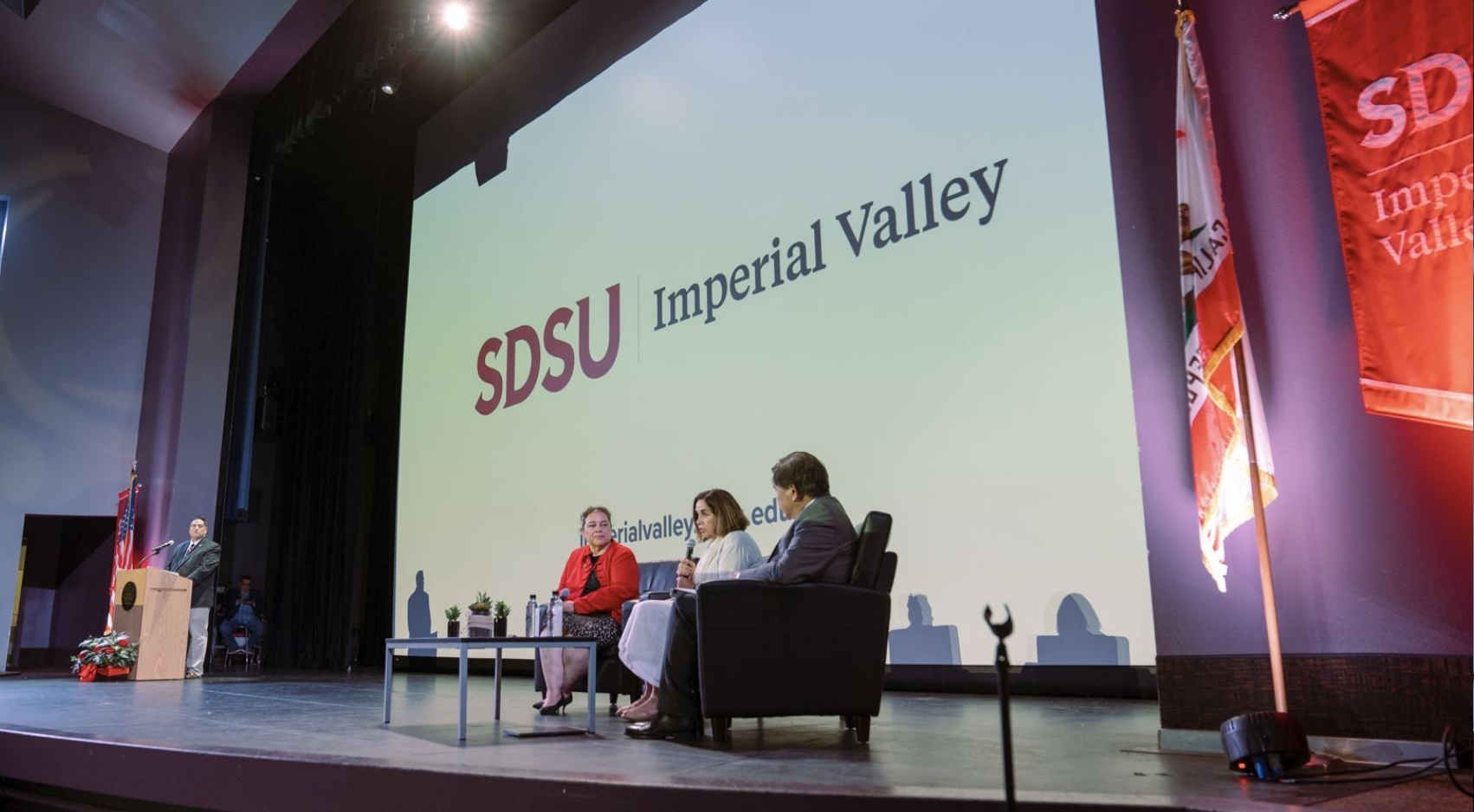Imperial Valley's Innovative Future Powered by a Shared Vision
More than 100 university and community leaders attended a town hall to discuss the shared vision for transforming SDSU Imperial Valley for the benefit of Imperial County residents.

Over about four years, San Diego State University has transformed the educational partnerships and opportunities in Imperial Valley, positioning the institution – in partnership with the community – as the county’s leading institution offering higher-education growth.
The new, shared vision for SDSU Imperial Valley, under the leadership of SDSU President Adela de la Torre, has resulted in new academic programs, student support services, more faculty and staff hires and additional funding for facilities.
Most recently, Sen. Ben Hueso, and Assemblymember Eduardo Garcia led the charge to secure $80 million in additional state funding, adding to the $15 million SDSU had recently committed to expanding SDSU Imperial Valley. This funding will result in the construction of a 65,000-square-foot science, technology, engineering, mathematics (STEM) campus and Innovation District in Brawley.
“There is a momentum here. There is an energy here that will move us rapidly forward,” de la Torre said during the SDSU Imperial Valley Town Hall, which was held Tuesday night in El Centro, Calif.
More than 100 residents, students, faculty, staff, business leaders, elected officials and education partners attended the town hall, during which university officials spoke about the most recent investments in SDSU Imperial Valley’s growth – and what’s to come.
“As the 4-year institution for Imperial County, we are completely moving to the next level, and it is going to happen faster because the community is aligned with the vision for Lithium Valley,” de la Torre said. “The future could not be brighter.”
Aligning the Stars for Imperial Valley
SDSU has reinstated 4-year programs at SDSU Imperial Valley, adding degree options such as the first STEM majors at the campus. The first STEM program – a B.A. in mathematics – began in Fall 2021, and a new four-year nursing program, a Bachelor of Science in Nursing (BSN), begins this fall. The nursing program is so in demand that it is full with a waiting list.
Also, through a partnership with SDSU Global Campus, SDSU Imperial Valley has introduced new options for working adults to complete degrees in business and childhood development.
“This is just the beginning,” said SDSU Vice Provost William Tong.
SDSU has also increased SDSU Imperial Valley faculty hiring by 350% as compared to 2018 and has added additional staff and new student support services.
The next major development will come through the Lithium Valley plan, one that has received both federal and state-level financial investments. SDSU Imperial Valley, its Brawley campus and the community are collaborating on a dramatic expansion in STEM education and research, connecting the major economic development plan in California.
“The stars have aligned. We are encouraging students to get educated in the Valley and to stay in the Valley as leaders,” de la Torre said.
Tong, also a Distinguished Professor of Chemistry and Biochemistry, said lithium will become even more critical for the state and nation’s energy needs in the coming years. Experts estimate the recently discovered reserve found underground near the Salton Sea could satisfy one-third of the global demand for the mineral, which is critical to the batteries required for many renewable-energy technologies.
“When Gov. Newsom mentioned that this is ‘The Saudi Arabia of lithium,’ he was not exaggerating,” Tong said. “We have a lot of lithium here, and we need scientists and engineers here. The demand for lithium will be enormous. SDSU is ready to train the next generation of STEM students here and a skilled workforce is needed for the Lithium Valley.”
Moving Forward, Meeting Dean Núñez-Mchiri
De la Torre said the university is positioned to become a transformative border institution. She said both Imperial County and the U.S.-Mexico border are tremendous assets for creating innovation and community change, which are coming through the new partnerships and opportunities now being created.
“SDSU Imperial Valley has been here for about 60 years and it has not done what it should have done,” de la Torre said.
“But in the last four years, we have made very specific commitments and investments to allow our faculty to grow and to work with community members,” she said. “And, now, with the 200 acres in Brawley and the $80 million state investment, we see more innovations.”
De la Torre said the region’s new higher education leader, SDSU Imperial Valley dean Guillermina Gina Núñez-Mchiri, is prepared to take the shared vision forward following her appointment to the role on Aug. 4.
The town hall provided an opportunity for the campus community to formally meet Núñez-Mchiri, a Calexico High School graduate and two-time SDSU graduate, who comes from a family of siblings who also graduated from SDSU.
“Gina is the perfect leader at this perfect time for Imperial Valley,” de la Torre said.
Núñez-Mchiri shared that her parents were farm workers whose teachings, support and sacrifices helped to ensure that she and her siblings could pursue degrees and find success. She carries their teachings with her, saying her role is to be a connector between SDSU and SDSU Imperial Valley with the community.
“We are looking forward to seeing your students through, not just in recruiting them,” Núñez-Mchiri said. “We are not teaching your students just to get a degree, but are educating the future leaders of our state and our community.”



